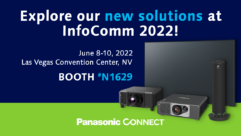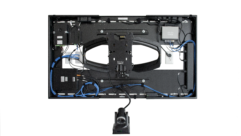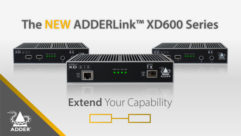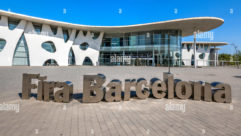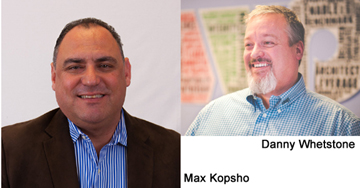
SVC Podcast – Show Notes – Show 131-1:
In this edition of the SVC Podcast, SVC Contributing Editor Bennett Liles talks with Danny Whetstone of DWP Live about their Large Scale Projection Mapping Workshop being held at Infocomm on Wednesday, June 17th from 8AM until noon. Danny outlines how the participants will be taken from concept to 3D Laser scan to execution. There will be hands-on demonstrations and practice on creation of wide screen effects. Then Bennett talks with Max Kopsho, SVSi Director of Training and Strategic Business Development about his two Infocomm courses, The Basics of Networked AV and Intermediate Networked AV, being held on Wednesday afternoon at the show.
Links of interest:
- Infocomm Course Listings and Session Search
- DWP Live, the projection mapping experts
- Connect with DWP Live
- DWP Rents
- SVSi, the Networked AV Solutions Provider
- SVSi sessions for InfoComm
- SVSi’s new online training
- In-depth 2-Day Networked AV session with considerable hands-on
Download Podcast Here:
https://s3.amazonaws.com/nb-svc/public/public/131-1_Danny_Whetstone_Max_…
From Sound & Video Contractor Magazine, this is the SVC Podcast with Danny Whetstone of DWP Live and Max Kopsho of SVSi. Show notes for the podcast are available on the web site of Sound & Video Contractor Magazine at svconline.com.
Infocomm is the place to be for AV training and the course list is impressive. Today we’ve got Danny Whetstone from DWP Live to talk about his Large Scale Projection Mapping Workshop and then Max Kopsho of SVSi will tell us about his classes on the Basics of Networked AV, multicasting, Layer-3 switching and codecs. That’s coming up right now on the SVC Podcast.
Danny, it’s a real treat to have you with us on the SVC Podcast from DWP Live, the projection experts in Smyrna, Tennessee and I think you’re also in Arcadia, California.
That’s correct.
Okay, you’ve got both coasts covered. So what goes on at DWP Live?
We’ve had an extremely busy last few months mapping objects and transforming environments all over the U.S. and also around the world. Our latest projects have included Arco Cinemacon event in Las Vegas. We’ve just finished the Robin Hood fundraising gala at Javitz in New York City, and then a pure storage event which spanned across four cities including London, Sydney, San Francisco and New York all in a single 24 hours. So we’ve been jumping around quite a bit. [Timestamp: 1:44]
Wow. With all of that going on I don’t know how your guys had time to do this one but there’s a lot happening with architectural projection. This isn’t something that goes back a long way but there have been a lot of developments in projection mapping just over the past few years.
Projection mapping has a whole world of potential and opportunities. Sometimes it also has limitations. We can’t fight against the sun, but a big draw is the ability to transform pretty much any object and something drastically different. It could be something like a building where we can harness the attention of people from miles away – like a project we just did in Miami you could see from several miles away – or to like a boring, drab ballroom and transform it into some fun, exciting place or something completely different. It really just all depends on the end goals of the customers and the budgets. [Timestamp: 2:38]
I would think that projection mapping enables a client, as you said, to completely re-do the appearance of a building like getting a whole new paint job every night.
Yeah. It can be anything you want; Christmas with Santa Claus or spring time with tulips. You name it. You can make it look however you like. [Timestamp: 2:57]
So when you get a project like this and you know what you’re up against, what are the main steps in planning a large-scale projection mapping project? How do you get started with it?
Well, Bennett, if you come to our class at 8AM on June 17 we can tell you a whole lot more, but for the basics just for now I would say the main steps include a site visit, either a laser scan of the building or the object you’re going to project onto or a photograph model can also do the trick. From there we kind of dive into content creation, calculate projectors needed and then select the right media for the job and then go out and execute it. [Timestamp: 3:35]
I would think that it’s pretty much the same steps to get underway but when you get onto the individual project, that’s when the real creativity starts.
Yeah, and you know there’s a lot of flexibility in projection mapping and using LED and mapping in general – both the projection and LED’s – and so there’s so much power in media servers these days, it’s pretty limitless. You’ve kind of got a base structure and then it’s just a matter of whatever you can dream of can be done. [Timestamp: 4:03]
Yeah, I was looking at one of the videos of your guys setting up a project and you’re dealing with some very heavy duty hardware. You’re using the big stuff but when it really comes down to the show, it’s all pretty much software driven isn’t it?
That’s true. Everything’s scalable. Our focus and our primary business is built around larger projects, but it’s all scalable to any type of size from a tennis shoe all the way up to stadiums. But there are so many different software options now. We’ve been heavily involved with Pandora’s Box for many years and we just dived in deep with D3 this year and the new 4 x 4 and 4 x 2 Pros. We’re also in the beta phase with Barco’s X-Agora. It’s really showing signs of progress as well. Besides what DWP carries in their inventory, there’s many more options on the market. My philosophy is the key isn’t always the product being used. Success, in my opinion, is far more dependent on the programmer than the hardware or software that’s actually being used on the job. [Timestamp: 5:12]
It’s probably a challenge just to get to where you can use the software and find out all the things you can do with it but once you get to that point you can show the client some things that are really impressive.
Absolutely. There is a big learning curve and those learning curves are getting more shallow as technology comes along and designers and engineers that are making the products keep making them easier to use. You still are going to have the guys that really push the limits of whatever box they’re using to some Nth degree that nobody else thought of. It’s a really open door for creative minds. [Timestamp: 5:45]
I also saw in the videos some very big projectors you’re using and that’s got to require a lot of power and it looks like you have to be not only be projection experts but power experts as well.
Yeah, I mean that is one of the big challenges especially in outdoor architectural projection. There’s not a lot of power that’s permanently installed for those kinds of situations and so we depend a lot on generators to bring power in. Sometimes we’re pulling power from different sources. The biggest key for us in managing power is number one, make sure that we get something stable. Most of the projectors we use are flexible between 190 volts up to about 250 volts. Wherever we fall in that line it doesn’t matter, but we want it to be stable. We don’t like it to fluctuate a whole lot. And so it calls in sometimes adding some additional transformers or shorter cable runs. It’s a lot of preproduction that goes into managing some of those power challenges that we have to overcome. [Timestamp: 6:46]
I’m sure that’s not the most glamorous side of it but that drives everything and you have to set up a strong power foundation for each project. You’re used to projecting onto a lot of different objects. I guess the sides of buildings would be the most common but can projection mapping be done on surfaces that aren’t solid like maybe water, fountains, vapor, flying cloth and that kind of thing?
Absolutely. All of those things can become a projector screen, especially water screens. You know, we’ve seen that for years at Disney. We’re actually working on a project now in the San Francisco Harbor that’s intending to do a temporary install on a large screen for some advertisement stuff as well as lots of cool vapor things that happen in some of the concert touring stuff. Another big, fun thing that we added recently to our inventory is BlackTrax, which also has the ability to map moving objects as well; so traveling scenery on the stage, cars that are moving, motorcycles that are moving, people, those kinds of things. It all kind of depends on the final outcome that’s desired. Showing Power Point on a flying cloth probably isn’t going to work so well, but if you want to make the flying cloth look like it’s on fire, then that’s probably doable. [Timestamp: 8:02]
Oh yeah, I’ve seen some things where it looks like the building is collapsing and there are fish swimming out of it and all kinds of stuff. So give us a quick outline. What do you plan to cover in the course when you get people together at Infocomm?
We’re going to divide the class up into four key subjects, kind of the areas that we mentioned before, and each of those subjects are directly linked to the other and they all have to work in harmony to have the best opportunity of success. So the number one subject we’ll talk about is 3D laser scanning and modeling as well as creating a photographic model. We’ll discuss why that’s important and how it’s accomplished and when to use the different avenues. The subject two we’ll talk about is content creation and development. We’ll have a couple of artists that will describe the process from concept to design and how to deliver the finished product to the projection experts. We will also include some key points regarding production, site preparation, permits, public access challenges, some of those, you know, outlying things that we all need to think about. Subject three will be all about projection. We’ll talk about some of the basic steps and how light is measured, how to calculated lumens per square foot, how to overcome several challenges in the field including ambient light in dark surfaces; those kinds of things we’ll touch on. And then the final subject we’ll talk about will be the media server and how to adjust the content onto an actual media server and what works best in those scenarios, and then how to use the warping engine to actually project onto a building or an object; build timelines. We’ll also talk about remote playback control for things that are more permanent installations, how to manage those over the internet, things like that, as well as timed installations, things that you set up once and they come on each day and run for a certain amount of time and shut off each day, and one of those things where we can harness the power of these new media servers to do things more efficiently. So that’s sort of the basics of what we’ll dive into. We’ll have experts in each of these fields to talk about each of these subjects and then I’m confident everybody’s going to walk away with some good knowledge at the end of the day. [Timestamp: 10:21]
I’m sure they will and as you said it’s Wednesday, June 17th from 8 a.m. until noon, the Large Scale Projection Mapping Workshop from the projection experts. Danny Whetstone and DWP Live in Smyrna, Tennessee. I think you’ll have plenty of takers on this one.
We look forward to it. We feel real honored to have the opportunity and hope we can share some key points that people can walk away and be as excited about projection mapping as we are. [Timestamp: 10:46]
Alright Danny. Thanks for being with us.
Thank you, Bennett.
And we also have with us Max Kopsho from SVSi and he will be teaching two courses in IT for AV. Max it’s great to have you back on the SVC Podcast. Everybody in AV has to know IT by now but before we get into what you’ll be showing everybody about that, tell us a little about what’s going on at SVSi.
So SVSi is a networked AV company. Obviously the industry has really made some leaps and bounds in networked AV, and SVSi has made some really great advancements in 4K. And the big question in the industry – and justifiably so – has been what is really 4K? And so SVSi has developed in 4K where 4K is actually 4K, so the color sampling is done at 4.4.4. It’s truly 4K at 60 frames per second or truly all the way 4K and then we can fall back. So the requirement on the network side is at least one full gigabit per second and then we also have fiber optic development where we can do 10 gigabits per second, which is where we are fully capable of doing full, uncompressed 4K. So we’re going to be showing some really cool products with video walls and the capability of doing full 4K. We’re showing some KVM products, so we are sending keyboard video and mouse over networking, some great advanced control solutions obviously sending video, but then also being able to do control solutions. And it’s all over standard network products, so the ability to do it over standard Layer 2 and Layer 3 networks and truly having converged networks. So being able to run your standard data networking and audio/video networks on the same network without having separate switches so it’s truly converged networks is really the big message that SVSi is sending. So you make the choice as the network administrator whether you’re going to segment your network physically or logically or whether you truly want a converged network. It’s up to the network administrator. They run their networks the way they want to run it. And then it’s SVSi’s message, whether you want to put it local, whether you want to put it on a local area network, or whether you want to do it on a wide area network. So from the marketing standpoint it’s in the room across the business or it’s across the entire enterprise, SVSi has the products that are going to allow you to deploy networked AV in whichever environment you want to do it. [Timestamp: 13:19]
And speaking of IT network managers, we know that as AV and IT hardware become very integrated what about the people side of it? How are network managers accepting AV applications on their networks now?
I think that’s a great question because the trend is heading that way obviously through hardware, and I think it’s heading that way through people as well. And what’s kind of interesting is what we used to see as being where it was government and education kind of were the lag in certain deployments, in people shift they’re actually the leaders when it comes to something like this where the hybrid person who is the network guy and the AV guy, they’re the leaders in this. So the network guys and the AV guys are the hybrid people in education and government now and then the larger corporations are shifting that way as well. And then the mid-sized and small corporations and such are making that shift more and more. But the interesting thing was that government and education were the first to make those shifts so it’s really fun to see that happen where in some other technologies that wasn’t the case. They were kind of slower to adopt some of those technologies and now they’re the first to do it. And it became interesting because it was also out of a business necessity that those people adopted the hardware and became the expert in their fields organizationally to adopt that personnel shift. [Timestamp: 14:55]
Well let’s get right to the central issue. What are the most important things for AV techs to know about IT networks, hardware and terminology?
I would say it is understanding the business need for it is really helpful. I think it used to be it was a nice-to-have kind of thing and there was a “gee whiz” aspect to it. And I think more and more people are understanding that there is a business need and a shift for the mission-critical aspect of it, so that helps to drive why we’re doing it and that makes the justification make a heck of a lot more sense. And then if you’re the technologist – and it really does mean understanding a lot more than just the buzzwords that go behind it on the implementation side – but just like in the medical field there are people who are specialists in particular areas and then there are generalists. The same would hold true in technology. I think the challenge is some people try to become experts at all things and that becomes the problem for them. So you really have to have people who are the networking gurus and have people that are the AV gurus and really play their strengths rather than try being all things to all people. So I would say when you’re deploying a networked AV system, seek out the experts and really leverage those experts because I, as an IT person, I don’t want to have to learn how to be the AV guy. I’m not trying to yet learn more and more things. I’m going to lean on somebody who knows acoustics and lean on their value and then as an AV person I can add my value to the equation by what I know and truly partner up and add my value to the equation without having to know everything. So I think that’s probably the most important thing is just know your value in the equation and partner up with somebody who has their CCNA or has their CompTIA Network Plus instead of trying to gather all of this information and be all things to all people. [Timestamp: 16:47]
It’s great to have a good working relationship between AV and IT people and you teach a lot of this. You’ve got two courses at the show and you’re going into the OSI model right after lunch. Do you think you can beat the after lunch carb crash with that kind of topic?
Yeah that is a challenge, I think. The OSI model is a tough nut to crack, like you said, right after lunch that the carb crash really hits everybody, but what’s really interesting is that that class filled up pretty quickly and we actually filled the class and then we went to Infocomm and asked for a larger room and they granted us that. So we’re actually opening back up the registration and allowing more people to sign up because it is a hot topic. So we’re accepting more registrations. It is really popular and we do want to allow more people to register for it because it’s a foundation. The OSI model is the foundation for all things networking and anything that anybody’s doing in networked AV is going to depend on that OSI model. If you want to have any conversations with a network person you’re going to need to know what Layer 2, Layer 3 mean and then why that is valuable to somebody in networking. And then based on that foundation you’re going to build on that for the rest of your networking, even if it’s networked AV, you’re going to build on that basis for the rest of your networked career, if you will. [Timestamp: 18:03]
And you’re really getting into the detail of this on Wednesday of Infocomm week. You’ve got participants going into multicasting, Layer 3 switching and codecs. So what should they come away with on this very detailed subject?
So yeah, we start off with the OSI model in the first class and then in the second class we do get a little bit deeper, like you said, and so we go deeper into the OSI model and talk about Layer 2 and Layer 3, and as you said multicasting and codecs because we want to talk about where the protocols play in each of the layers and where their values are. So we want to talk about and compare and contrast Layer 2 and Layer 3 and what the merits are and where the disadvantages of both Layer 2 and Layer 3 are so that people can kind of say okay, this product works well for this type of network and this product works well for this type of network and these products don’t work for these types of networks and be able to make well-informed recommendations to IT managers and at least start to ask good questions that make sense to the manufacturers and if nothing else know when to deploy appropriate knowledgeable people for help. So when it comes down to okay, now it’s gone beyond what I know at least know where to find the resources to get the additional help, whether it’s from manufacturers like SVSi – because we have CCNA’s and we have network engineers on staff – as well as partners throughout the industry whether it’s an AV vendor who’s an integrator or who doesn’t know as much about networking. They know where to find resources, whether it’s in their regions or wherever, to say okay now I need a network engineer. Where can I find somebody who’s going to know more about Layer 2 and Layer 3 and where the values are so that we can ask these questions and kind of pinpoint what’s going to be of value to this particular customer or not. [Timestamp: 19:53]
There’s a lot to know and these courses are really made of gold in their value on getting the course material but also on the one-on-one Q and A with people who know all there is to know on it. So what do you see as the common problems or challenges in AV networking design?
I think one of the biggest problems – and it’s probably with just about any type of design – but it really comes down to where a lot of assumptions are made. People make a lot of assumptions when they’re designing a network that it has to be logically segmented, whether it’s using VLANs or completely physically segmented. So a lot of people will automatically jump in and start to talk to a network administrator and say well you can put your audio visual stuff on a completely physically separate network and sometimes that will shut down a network administrator immediately because they like control over the entire system. Not because they’re control freaks, but because when you’re responsible for something and accountable for something, you need to have the ability to see everything and control everything – again, not because you’re a control freak but because if you’re responsible and accountable you need to be able to manage it. And so you say it’s going to be physically segmented, that might shut somebody down. But you make the assumption that that’s what they want because their fear of bandwidth issues and things like that, so you make that assumption and then that shuts them down. So again, probably the number one concern or challenge is that we make assumptions. Instead, what we should be doing, is asking questions of the customer and including the right knowledgeable people, again, so that they’re in the design process we can ask the right questions. And probably the biggest challenge is that we don’t have the right IT people as part of the sales and needs analysis process, and of course the design process, early enough in the cycle to get the right information from them up front. So we have the customer with us, but we don’t have the right people from the customer to get the IT information and get the IT buy in early enough in the process. So we kind of almost start over again once we’ve sold the system, if you will, to the customer and then we have to resell it to an influencer – and IT guy – within the customer’s organization. That’s probably the two biggest problems are the assumptions and then having to resell it again to the IT guys. [Timestamp: 22:12]
And of course in this business things are changing so fast, do you see any specific network technology on the horizon that has very profound implications for AV; something that’s going to change everything?
We’ve said this so many times, but with bandwidth to the desktop or bandwidth to even the home continually being increased and then the per port costs going down, I think there’s going to be a considerable impact on the way we deliver audio visual to things. So we keep talking about the internet of things and all of that stuff, so the connectivity of all of these devices, the amount of bandwidth that’s available to every device, means that multimedia is going to be switched in a considerably different way, the way we deliver information. And then the processing power that’s going to be – is available – and then it’s going to continue to increase dictates that the types of things that we’re going to be doing, whether it’s windowing and wall processing or other types of control and functionality, the expectation of multimedia to every device is going to be phenomenal. So the end user expectation of almost any video anywhere – so my expectation as an end user is going to be I should be able to switch any video source to any video display at any time, enterprise wide, is going to be realized because of bandwidth and because of processing power. Because my expectation is I can move data around anywhere, I should be able to treat audio video like data and that expectation is actually not unrealistic with those two things – bandwidth and processing power. Those are there and very much so in your future, so I think the end user expectations are quite realistic. [Timestamp: 23:54]
Alright. Well, you’re going to have a lot to tell those in the courses. “The Basics of Networked AV” on Wednesday. Is that the one in the morning?
No. We start at 1:30 in the afternoon and then we have another one very shortly afterward, so they’re really going to kind of build on each other. And like I said, we did get the bigger room so we’re going to be able to host up to 80 people in this room and then we stay in the same room. So we actually have some people staying over just jumping from “The Basics of Networked AV” into “Intermediate of networked AV.” It’s a manufactured training from SVSi, but we’re doing a very conscious effort of keeping it as objective as possible to just really make sure that we get this networked AV concept across as best we can without being in your face about SVSi product. [Timestamp: 24:39]
All right. I know it’s going to be a couple of great courses and people should reserve their seats. That’s Max Kopsho with SVSi and getting deep into networking technology for AV applications. Thanks for telling us about it, Max.
Great. You’re very welcome and thank you for having me.
Thank you for being here with us for the SVC Podcast with Danny Whetstone and Max Kopsho. Show notes are available on the website of Sound & Video Contractor Magazine at svconline.com. Join us again for the next SVC Podcast.



